Spinach, with its abundant health benefits, has become a staple in many home gardens. The journey to growing hearty, nutrient-rich spinach begins with understanding the growth requirements of this hardy plant and the vital role soil plays in the process. Every type of soil tells a story about what it can offer to the plants: its nutrient content, pH level, water-holding capacity, and more. Identifying the perfect soil for spinach is instrumental in the nutrition and growth of the plant. By delving into the types of soil that provide an ideal environment for spinach to thrive, and emphasizing the use of suitable soil amendments, we can harness the full potential of nature to grow this rewarding crop.
Understanding Spinach Growth Requirements
Cultivating Spinach: Understanding the Unique Growth Requirements
Every hobbyist gardener at some point finds a plant that speaks to their green thumb and for some, that plant is the resourceful spinach plant. Renowned for its dense nutritional punch, lush green leaves, and rich flavor, spinach leaves an indelible mark on the gardening experience. Cultivating spinach, though generally simple, requires keen knowledge and consistent care.
Reader Poll: What online courses would interest you?
Spinach thrives in cooler climates where the temperature ranges from 35 to 75 degrees Fahrenheit. High heat is not a friend of spinach and can lead to premature bolting, which is when the plant starts producing seeds and the leaves develop a bitter taste. Therefore, timing is key when growing spinach. In most regions, a spring or fall planting will yield the best results.
Soil maintenance is another key element in spinach cultivation. Spinach favors a slightly acidic to neutral soil with a pH ranging between 6.0 and 7.0. Preparing the soil by incorporating organic compost or well-rotted manure improves drainage and provides necessary nutrients for optimal growth. A well-drained soil is a must to prevent soggy, waterlogged conditions that can lead to root diseases.
Light is another determinant in spinach growth. Spinach, unlike most vegetables, can tolerate some shade. Although it prefers full sun, it can manage with as little as three to four hours of sun per day. This makes spinach cultivation a unique fit for areas of your garden that might not get constant direct sunlight.
Subscribe to our newsletter!
Water is a fundamental requirement for all plants, and spinach is no exception. Regular watering is crucial for preventing the soil from drying out. Spinach prefers a consistent supply of water, good soil moisture, but with superior drainage. It is important to water spinach deeply at least once a week to encourage robust root growth and avoid shallow root systems.
Spinach is a fast-growing plant, with most varieties ready to harvest in as little as 40 to 45 days. The leaves can be harvested once they reach a desirable size, and if properly maintained, the plant will continue to produce new leaves for an extended harvest.
The beauty of spinach cultivation lies not just in the nutritious leaves it produces, but also in the unique learning opportunities it offers. From understanding climate needs to comprehending soil pH ranges, every hobbyist gardener gains valuable insights into plant growth requirements, making the spinach plant a notable addition to the garden plot. It is in the understanding and meeting these unique growth requirements that a hobbyist gardener relishes in the wonder and reward of nurturing a spinach plant from seed to harvest.
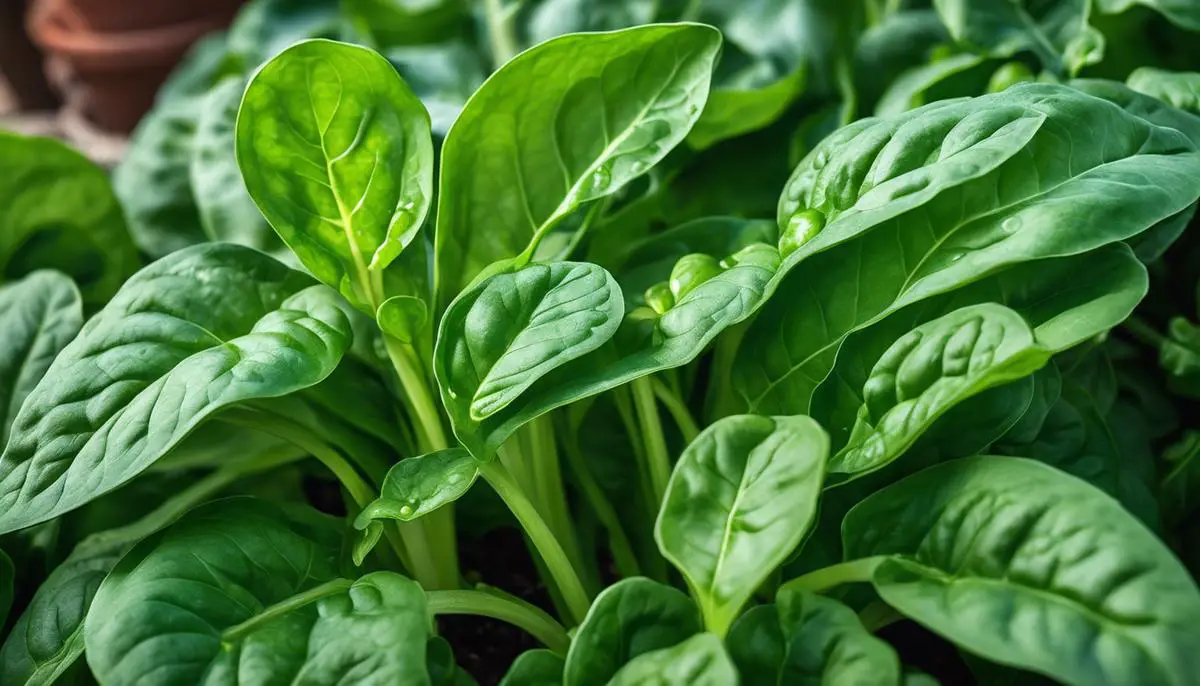
The Key Role of Soil
Unraveling the Wonders of Soil for Robust Spinach Growth
Perfecting the art of cultivating spinach doesn’t only lie in timing, watering, or the temperature requirements. Yes, they are important, but the secret weapon in any spinach gardener’s arsenal is understanding the impact of soil. Soil plays a significant role, serving as the womb from which our leafy greens spring forth. Its composition, structure, nutrient content, and water retention capability are critical to the successful growth of spinach.
Primarily, spinach demands a rich, loamy soil that has a copious supply of essential nutrients. Loamy soil is a balanced mix of sand, silt, and clay, providing an airy, well-structured medium for spinach roots to penetrate deeply. Most critically, this soil type optimally absorbs and retains water correctly without causing waterlogging, a condition spinach roots abhor.
Spinach plants equally require soil abundant in organic matter, which acts as a reserve for key nutrients such as nitrogen, phosphorus, and potassium. These elements are crucial for the healthy development of spinach. Nitrogen aids in the production of lush, green leaves, phosphorus supports strong root development, and potassium promotes overall plant health. Nonetheless, remember that an abundance of nitrogen can result in overly lush foliage with delayed maturity.
Amending your soil with organic matter also improves the soil’s structure, enhancing its water retention and aeration capabilities. Remember, the right balance is crucial here. Too much water can lead to root rot, while too little dries out the soil and stunts growth.
Soil fertility is also an essential determinant in the success of spinach growth. Fertile soil contains an abundance of microorganisms. These tiny organisms help break down organic matter into a form that plant roots can absorb. Therefore, ensuring your soil is fertile can be as simple as adding compost or aged manure.
It’s also worth considering the soil’s texture when planning to plant spinach. Loamy soil with a fine to medium texture is the ideal choice. The appropriate texture plays a crucial part in root expansion, allowing the roots to easily penetrate the soil, which inevitably leads to growth acceleration.
In conclusion, having a deep understanding of soil and its dynamics can drastically affect your success when growing spinach. The soil provides many of the imperative factors that a spinach plant needs to grow robustly. So, the next time you’re planning your spinach plot, remember to pay keen attention to your soil’s composition, nutrients, water retention capabilities, organic matter content, fertility, and texture. Spinach cultivation isn’t just a hobby but a journey into understanding the very fabric of life on Earth – soil. With these insights, you’re well on your way to enjoying a hearty spinach yield soon.
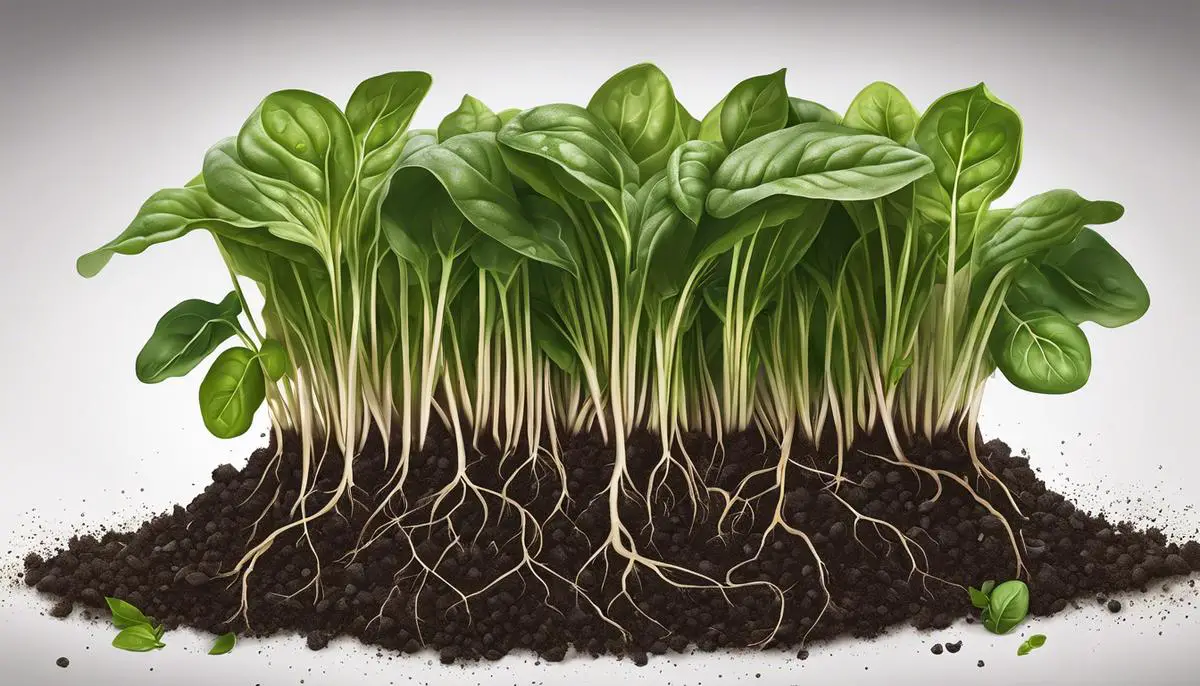
Ideal Soil Types for Spinach
A Deep Dive into Soil Types Best Suited for Spinach Growth
Soil selection for growing spinach—the favorite leafy green of many hobbyists and home gardeners—holds great significance, as much as the other topics we’ve discussed so far. Professionals might find it insightfully intriguing, almost as fascinating as gardening beginners would find it helpful. So, let’s dive deep into the fertile world of soil.
Healthy, bountiful spinach crops favor loamy soil. Such soil, a balanced blend of sand, silt, and clay in approximately 40-40-20% respectively, offers several advantages for spinach cultivation. Loamy soil—neither too heavy nor too light—provides the perfect environment that enables spinach roots to grow deep and spread, absorbing nutrients efficiently from the soil.
The secret behind loamy soil’s appeal lies in its exceptional ability to retain moisture, yet drain excess water effectively. This characteristic makes it ideal for growing spinach, ensuring the soil remains evenly moist without becoming water-logged. This satisfies the leafy green’s craving for consistent water supply without subjecting it to a mud bath.
The nutrient-rich structure of loamy soil is another aspect that makes it desirable. Loamy soil—one that’s generously loaded with organic matter—supports a healthy community of microorganisms that naturally enrich the soil with essential plant nutrients. This synergy of Mother nature’s finest critters in the soil bolsters the growth of spinach, promoting lush, healthy leaves.
The right balance of nitrogen, phosphorus, and potassium (N-P-K) is vital for spinach growth. For the ultimate health and vigor, spinach prefers soils high in nitrogen content for leaf development, along with appropriate levels of phosphorus and potassium for promoting root growth and resistance against diseases. Loamy soil’s natural ability to facilitate the balanced absorption of these nutrients gives it a gold star in spinach farming.
But what about other components? All these elements, in perfect harmony, will be in vain if the balance of water is not right. Despite craving moisture, spinach, like most plants, doesn’t bode well with waterlogged conditions. Therefore, a well-structured loamy soil ensures sufficient water is retained for the plant’s needs but prevents water from stagnating, thus reducing the risk of root rot.
Finally, the soil’s texture also participates in this intricate dance of spinach cultivation. Medium-textured soils, like loamy soil, provide the right balance between water-holding and drainage, as well as ease of cultivation and root penetration. It’s like giving spinach the power of a super-grow environment.
In a nutshell, a rich, well-structured, and well-drained loamy soil creates the optimal conditions for spinach to thrive. Engaging with the dynamics of soil enables growers to achieve successful spinach harvests, adding not just to the dinner table but to a deeper understanding and appreciation of this rewarding hobby. Happy Gardening!
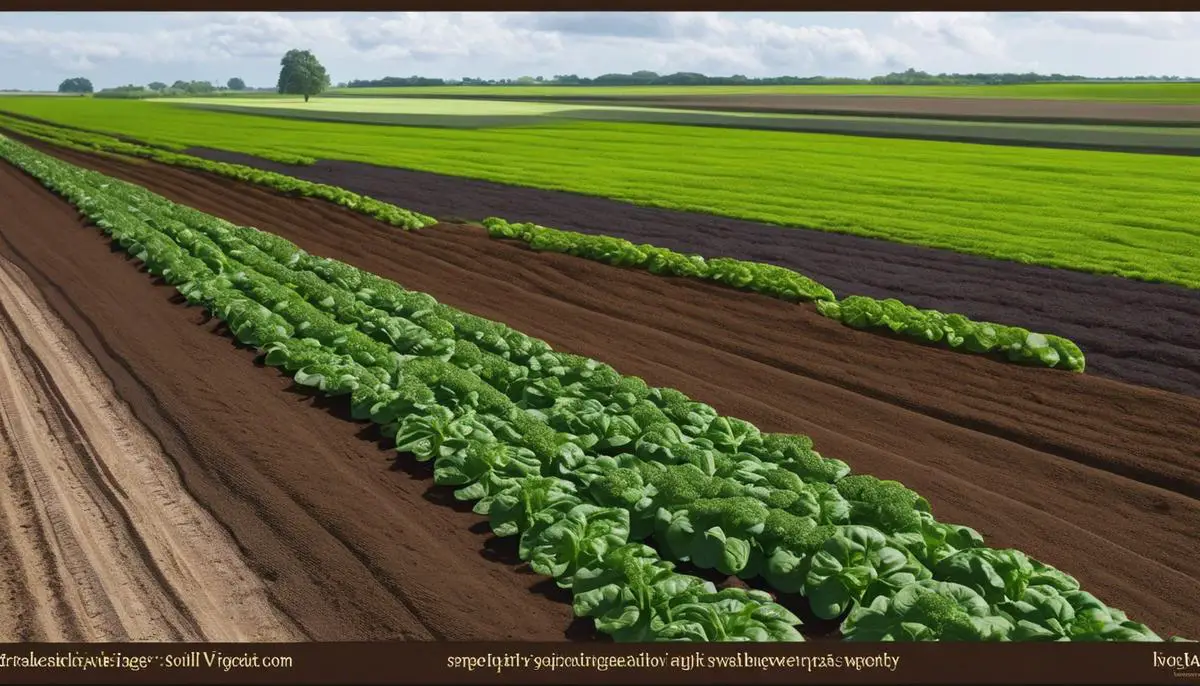
Soil Amendments for Spinach
Boosting Spinach Growth: Soil Amendments Simplified
One of the great things about growing spinach is that it gives you the chance to really get your hands dirty, both figuratively and literally. Working with the soil is the first step in a successful journey to bountiful spinach harvests. While the soil’s pH and texture are important, we can further optimize spinach growth by amending the soil with a few additional elements.
Firstly, it may be beneficial to include bone meal in your soil amendments. Spinach is a leafy green, so it needs a substantial amount of phosphorus to promote healthy leaf growth. Bone meal, a byproduct of animal slaughter, is a phosphorus-rich additive that can significantly boost leaf growth. But be careful – too much phosphorus can hinder the uptake of other important nutrients by the spinach plant. Moderation is key here.
Together with phosphorus, spinach also needs a reasonable amount of nitrogen. This nutrient is vital for the overall growth and wellbeing of the plant. Nitrogen can be added to the soil using feather meal or blood meal, both of which are known for their high nitrogen content. The blood meal also adds a fair amount of iron to the soil, supplementing the spinach with this crucial nutrient to stave off chlorosis, a common issue in spinach plants.
Potassium is another key ingredient for successful spinach cultivation. It can be added to the soil via sulfate of potash or crushed granite. These act as slow-release sources of potassium, contributing to overall plant health, disease resistance, and improved flavor.
Next, don’t underestimate the value of micronutrients. They act as catalysts for various growth processes. A trace mineral blend containing boron, copper, and manganese can be mixed into the soil to provide a comprehensive range of micronutrients.
Last but not least, remember the importance of calcium. Spinach plants need a sizable amount of calcium in the soil to develop strong cellular structures. Gypsum or ground, dried eggshells are excellent sources of calcium. They not only promote the thriving growth of spinach but can also assist in maintaining the balance of the soil’s pH, keeping it neutral for optimal growth.
In conclusion, while the inherent properties of the soil are fundamental for spinach growth, some thoughtful amendments can pave the way to more vigorous and richer harvests. With some practice, attention to detail, and a bit of soil science, your spinach blossoms will be the envy of all. Happy cultivating!
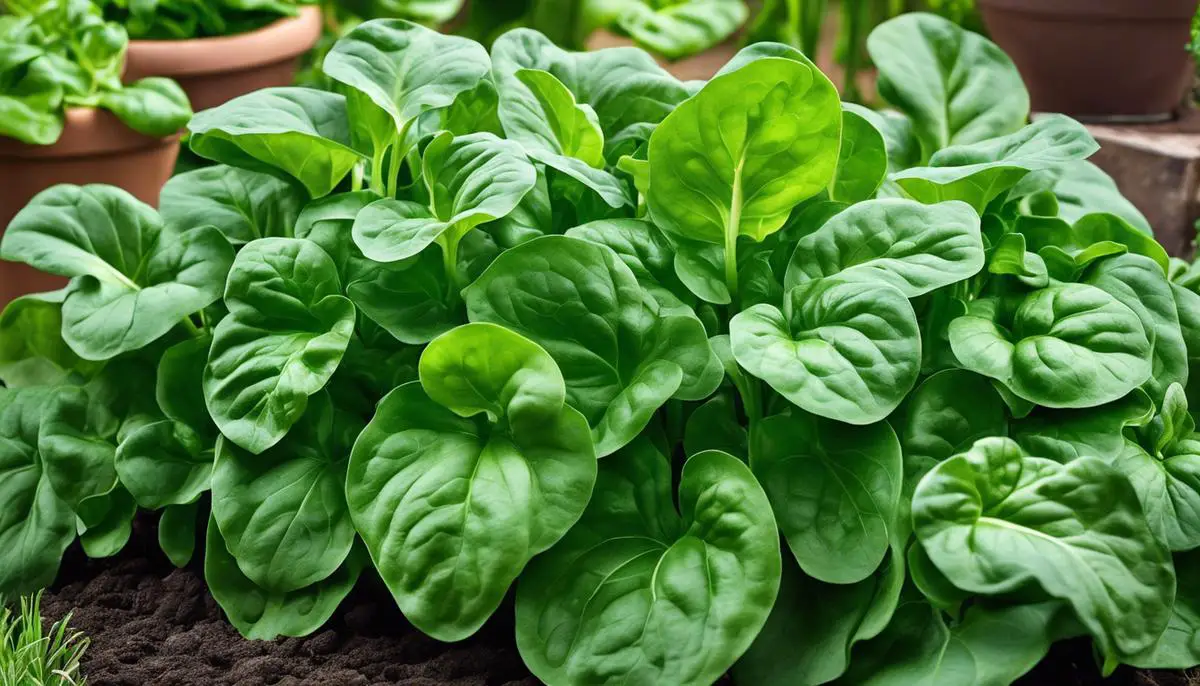
Daily Soil Care Tips
Maintaining Healthy Spinach Soil: A Daily Regimen
Having dived into the broad understanding of spinach growth, soil composition and amendments; today, the focus is on the day-to-day care for spinach soil, keeping it healthy, nutrient-rich and conducive for optimal spinach growth.
A crucial daily practice is monitoring and maintaining soil moisture. While it’s essential to keep the soil from drying out, it’s equally important not to overwater, making the soil loggy and potentially causing root diseases. A simple way to monitor this is by feeling the soil; if it clings together but doesn’t feel waterlogged, it’s just right.
Maintaining an ideal soil temperature, somewhat cooler than the air temperature, is also key. Mulching can help achieve this by acting as an insulating layer, minimizing temperature fluctuations. It also helps retain soil moisture and inhibit weed growth. Environment-friendly options like straw or shredded leaves can be a great choice.
Churning the soil from time to time helps aerate it, making it easier for the roots to penetrate deeper and access more nutrients. While doing so, care should be taken not to damage the spinach plant’s delicate root system. This activity also gives an opportunity to weed out any undesired plant growth.
Keeping an eye on the color and feel of the leaves can give hints on the soil’s nutrient levels. Pale or yellowing leaves could indicate a nitrogen deficiency, explained earlier as vital for spinach development. In such cases, mild doses of a nitrogen-rich organic fertilizer can replenish the soil.
Calcium, which was discussed for its role in strong cellular structures and pH balance, is another element to watch for. Calcium deficiencies often appear as distorted or dead growing points on the spinach. This can be corrected by adding a slow-release calcium source, like gypsum or limestone, according to package instructions.
Regular applications of organic matter, like compost or well-rotted manure, not only supplement the soil with nutrients but also enhance its structure and water retention. Be careful to not apply fresh manure as it can burn the spinach plants or introduce pathogens.
Another good daily practice is crop rotation. While this won’t be a daily task, planning for it should be an integral part. A 3-year gap between spinach crops in the same spot can help prevent build-up of soil-borne diseases and nutrient depletion.
A final word of wisdom; like any other relationship, the one with soil is symbiotic and based on respect. Honoring the soil life, being aware of its needs, replenishing it timely, and not exploiting it will reward with a bountiful spinach harvest in return. Remember, most of these practices are part art and part science, nuances are learned and honed over time, and the joy of cultivating spinach is in this journey. Back to the soil tomorrow for a deep dive into adding more yum to that spinach!
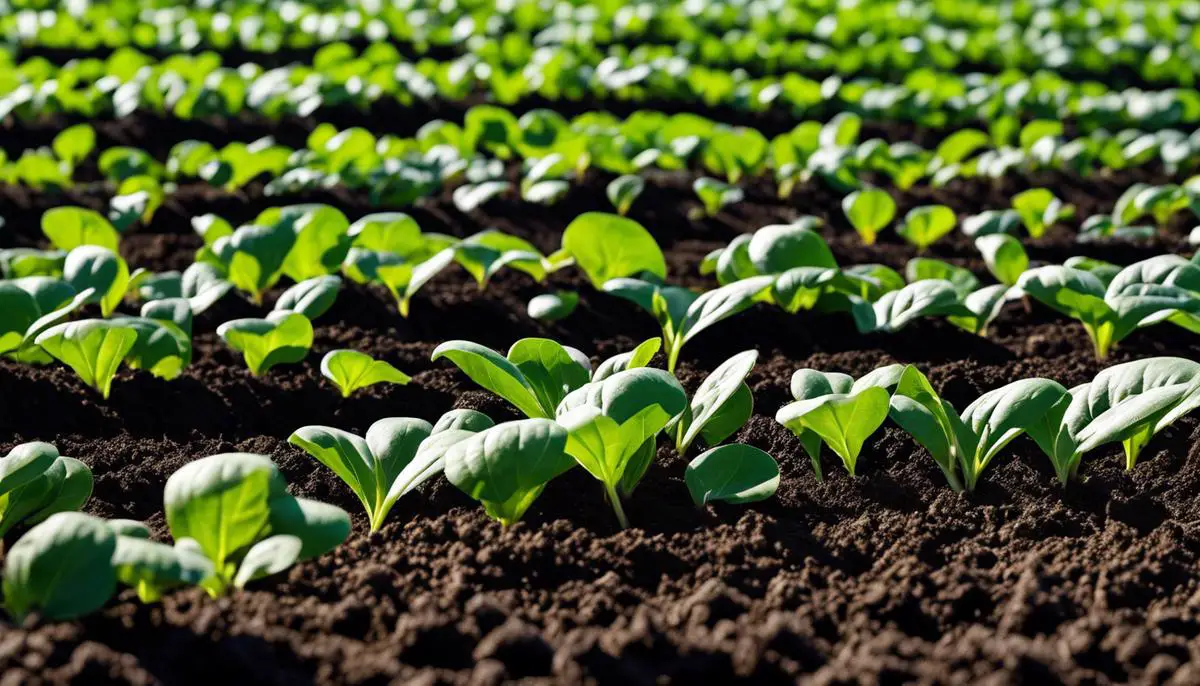
From loamy gold to the daily care rituals that keep the spinach greens vibrant and healthy, it is evident that the secret to bountiful spinach lies beneath our feet – in the soil. The soil isn’t merely a medium to hold the plant upright, but the source of life-sustaining nutrients, a facilitator for water transport, and a barrier against diseases. Deliberate measures to enrich the soil with organic or inorganic amendments and maintain its vitality through regular care practices, emphasize the importance we attribute to this often overlooked aspect of gardening. Ultimately, understanding and nurturing the soil leads to the reward of watching robust spinach sprout from the ground, reminding us that every leaf harbors the vitality of the earth beneath it.

